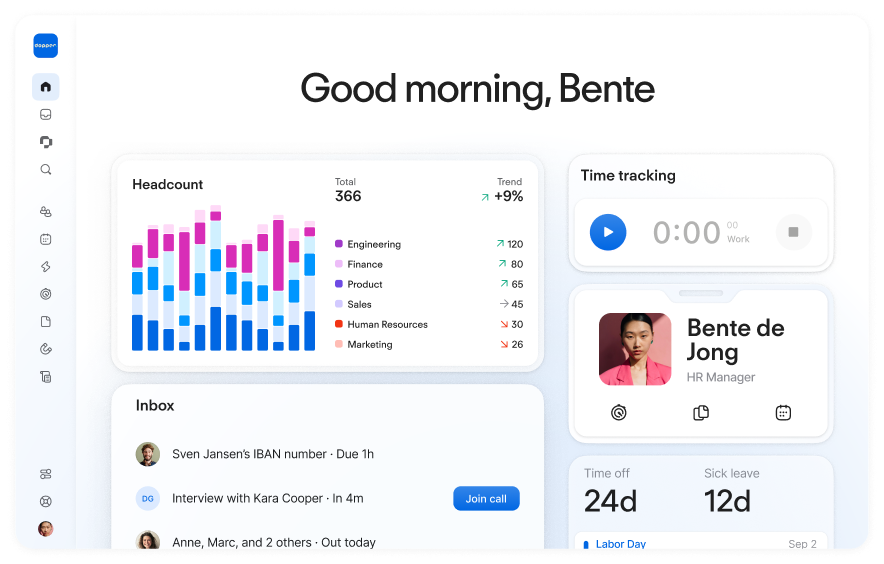What Is the Digital Workplace, Really?

The digital workplace is now commonplace in the UK. Companies in all sectors are embracing virtual components and positions for at least part of their operations.
And, it’s no trend! Virtual workspaces are here to stay. Below is an in-depth look at the increasing use of remote workers to help decide if it’s right for your business.
Key Facts
A digital workplace requires incorporating technology to streamline company operations and connect your employees.
Digitalising some or all of your company’s processes can expand your business operations and widen the pool of candidates you can draw from.
Data can be more vulnerable to external tampering, so cybersecurity should be a major consideration when planning your digital workplace.
Contents
- 1What Is a Digital Workplace?
- 2What Are the Key Components of a Digital Workplace?
- 3Benefits and Disadvantages of a Digital Workplace
- 4How To Overcome the Challenges of a Digital Workplace
- 5How To Increase Employee Engagement in a Digital Workplace
- 6What Is a Digital Workplace Strategy, and Why Is It Important?
- 7Frequently Asked Questions About the Digital Workplace
- 8Simplify the Shift to Digital HR with Personio
What Is a Digital Workplace?
A digital workplace is a type of workplace where employees can access their work online, and theoretically complete their work in a distributed, asynchronous fashion. A digital workplace often encourages effective collaboration within hybrid business models.
What Are the Key Components of a Digital Workplace?
There are several key components central to a successful digital workplace. A digital ecosystem without one or more of the following components could harm your business’s efficiency and productivity.
1. Effective Communication Channels
Dependable communication channels are the bedrock of a successful digital workplace. Real-time communication (called synchronous) through platforms like Slack and Teams is vital to productivity and accuracy. It’s also key for leaders to organise collaborative efforts. While asynchronous forms of communication like emailing are still important, synchronous communication ensures all stakeholders receive updates in real time while it’s relevant to the tasks at hand.
The balance between using both synchronous and asynchronous communication channels looks different at each organisation. Each department may want to set a precedent and create a system that works best for their team.
2. Streamlined Processes
The digital workplace infrastructure enables the company to virtualise many vital processes and streamline them through online software. These cloud-based platforms ensure that anyone with permission can access the correct information in real time, so nobody is out of sync with what’s going on at any given moment. This software also automates more tedious portions of specific tasks, making your company’s workflow an overall more efficient process.
3. Project Management
Certain digital resources enable teams to track large projects with complete accuracy. Online platforms allow team members to stay up to date on progress no matter where they are while helping them align their efforts around a clear goal. Additionally, the team leader can more easily split large tasks into smaller action items for each member while emphasising the desired deadline.
4. Enhanced Security
A digital framework can save employees time and increase productivity, but company information still needs to be safeguarded. The more processes that migrate online, the more you will need to invest in security protocols that protect essential data and cover any possible vulnerabilities.
5. Analytics Tools
Companies produce large amounts of data often used to provide insight into the company’s financial health and overall market success. In the past, this data was tracked and analysed by hand, which could easily introduce human error into the process and inadvertently lead to incorrect conclusions. Now, digital analysis tools can produce more accurate and actionable insights from vast quantities of information. Not to mention, these tools can also ensure the accuracy of the analysed data.
Benefits and Disadvantages of a Digital Workplace
In a technology-driven society, a digital workplace transformation has its fair share of advantages. However, company operations reliant on digital tools can present unique challenges that are important to consider before implementing them.
For example, a digital workplace can create interconnected business operations across the globe. An expansive network of employees allows the business to take advantage of unique opportunities or resist unexpected disruptions like extreme weather. But that network depends mainly on having a reliable internet connection. Something happening to that connection can bring normal operations to a halt.
Below is an overview of other benefits and drawbacks of a digital work environment:
Advantages | Disadvantages |
|---|---|
A digital workplace increases employee engagement by streamlining arduous processes and making it easier to communicate with colleagues. | A digital workplace can discourage developing interpersonal relationships by replacing face-to-face interaction with messages. |
Digital communication channels create a reliable way for employees to share ideas and deliver feedback with less risk of misunderstandings. | A digital workplace can create a dependency on the latest technologies, even in in-person settings. |
It widens the talent pool the company can draw from, making it easier to find top talent. | Upgrading outdated programmes and equipment is costly, and it can take time for employees to acclimate. |
A digital workplace increases overall efficiency, which in turn can increase revenue. | Moving a company’s data online may make it more vulnerable to hacks and leaks without proper protection. |
How To Overcome the Challenges of a Digital Workplace
Some companies are more prepared to adapt to a virtual work environment than others. Digital workplaces help solve some of the challenges of working in a physical space but introduce new ones that must be overcome. Some solutions to the obstacles you may encounter are:
Complexity. When picking tools for your digital workplace, stick to only one or two brands. This limits how many systems employees must learn while ensuring that new programmes work well together. It also ensures that the systems work with one another.
Resistance to Change. Virtualising a workplace changes the dynamics and processes built in the physical one. Long-term employees may have particular difficulty learning new systems, but having training programmes in place to bridge knowledge gaps can aid the transition.
Data Vulnerability. Digital information is more vulnerable to external tampering than physical documents or information stored locally (on a device that is not connected to the internet). Many companies do not consider data protection in the initial stages of their digital workplace strategy. But having cybersecurity in mind from the beginning can help keep your company’s data secure in the long term.
More Distractions. Digital workplaces can encourage productivity through more flexible work accommodations, but that environment can also introduce a lot of distractions. Cut down on tab-switching by streamlining all work processes into a platform with built-in tools that encourages workers to focus on their responsibilities.
How To Increase Employee Engagement in a Digital Workplace
Companies that switch to a digital workplace can have some initial trouble maintaining employee engagement. But there are several methods to keep your employees invested in their work, even if they aren’t present in a physical office space.
Automate Your Onboarding Process. Onboarding is an essential and involved process that automation can make much more manageable. An online programme streamlines the process, removes redundancy and saves time for the new hires’ training, allowing them the best start possible.
Recognise Your Employees’ Contributions. Workers often feel more engaged when reassured their work is essential to the company. Recognition of their efforts, even when employees are not present in person, encourages employees to keep up the good work.
Implement Robust Collaboration Tools. A digital workplace connects people from across the globe, but that does not always mean those people feel connected. Implement multi-channel communication tools to help ensure your workers feel like part of a team even when working remotely. Consider implementing additional opportunities to connect. Virtual happy hours or establishing a ‘watercooler’ channel for casual conversation within your communication tools are two ways to foster camaraderie.
Invest in a Mobile Platform. Most people have mobiles, and some have mobiles specifically for work. Look out for app-based programmes that can be installed on their phones, so employees can stay connected during work hours, no matter where they are.
Ensure a Higher Employee Engagement

Motivate your employees with regular, transparent feedback and make them more productive.
Learn more hereWhat Is a Digital Workplace Strategy, and Why Is It Important?
A digital workplace strategy describes how your company plans to implement digital workplace technologies with as little disruption to employees’ responsibilities as possible. It helps you direct the introduction of new tools and pace it to avoid overwhelming your workforce and possibly decreasing morale.
A detailed strategy includes descriptions of the resources you’d like to implement and how they can benefit your company. This makes it easier to prioritise which technologies to integrate first.
What Are the Main Elements of a Digital Workplace Strategy?
The most effective digital workplace strategies can be broken down into several key elements to ensure the transition goes smoothly. The most important aspects to remember are:
Vision. Have an idea of what you want your digital workplace to look like at the end of your company’s shift. It can be a specific, outlined goal or a more general aspiration, but having one in mind helps define the steps needed to reach it.
Alignment With Your Organisational Strategy. Detail how the benefits of your digital workplace strategy directly impact the overall company goal. Implementation requires a lot of time and resources, so getting support for the initiative will be hard if it isn’t relevant to other objectives.
Defined Scope. Determine the extent of the company’s shift to virtual operations. Does your strategy impact every employee or only specific sectors? To what extent does it affect the customer experience? What company process will it affect? Clarity on these questions and more helps keep your strategy realistic.
Established Criteria for Success. Determine the metrics you’ll use to track the success of your digital workplace. Doing so before you begin implementing new technologies helps keep the initiative focused on improving company processes that directly impact that metric.
Frequently Asked Questions About the Digital Workplace
What Is Meant by the Digital Workplace?
Digital workplace refers to the online tools that allow employees to complete their work from anywhere, at any time.
What Is an Example of a Digital Workplace?
A company that revolves its work process around using Slack or Asana to communicate with its employees creates a digital workplace.
What Is the Difference Between a Digital Workplace and a Workspace?
A digital workplace is a platform for letting employees communicate with each other. A digital workspace is a platform employees use to complete their work.
Simplify the Shift to Digital HR with Personio
Employees no longer need to arrive in person on their first day at work. In a digital workplace – and with the help of Personio – HR can onboard employees and manage their day-to-day needs from anywhere. It’s made easy for employees and managers as well, with tools that let them manage time off requests and other essential tasks with a few clicks.
Beyond typical HR tasks, Personio offers powerful tools for payroll, performance management and feedback, recruitment and much more all within the app. Book your demo today to learn how Personio can take your digital workplace to new heights.
Disclaimer
We would like to inform you that the contents of our website (including any legal contributions) are for non-binding informational purposes only and does not in any way constitute legal advice. The content of this information cannot and is not intended to replace individual and binding legal advice from e.g. a lawyer that addresses your specific situation. In this respect, all information provided is without guarantee of correctness, completeness and up-to-dateness.

